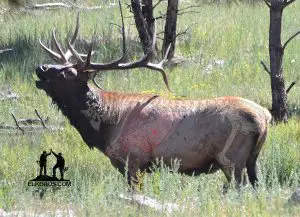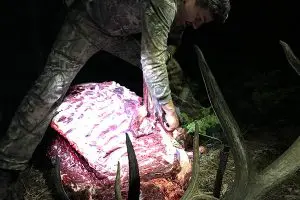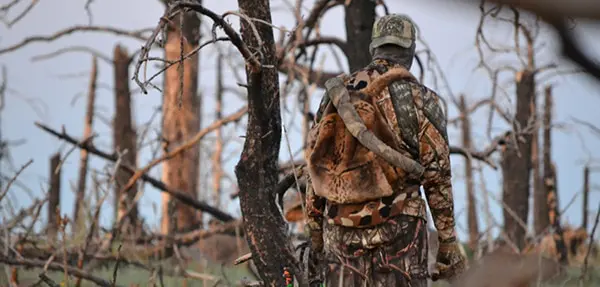
When it comes to camo, there are tons of choices out there. All kinds of patterns. All kinds of materials. All kinds of price ranges.You might already have a pattern, brand or material of choice, which is great. But for those of you that are still trying to get through the jungle of camouflage offered (HaHa…see what we did there!), your coaches are here to give you some tips that might just help you out when making future decisions.
Also, our camo needs to be useful and versatile whether hunting mulies, whitetail, elk, cats or canaries. It doesn’t matter what the heck we are hunting.
Our purchases are based on basically two things. Silence of the material and contrast of the pattern. Sure, there are other factors that may guide or influence your needs based on time of year, weather or how extreme the conditions will be. But our first and foremost test is totally based on silence and contrast.
Silence

To us, it totally DOES NOT matter how good a pattern is if we sound like a doggone shower curtain walking through the woods. It is imperative that our camo, and our gear as well, is as silent as possible in all of our hunting conditions. We want to be able to move freely, …draw our bow, walk through brush, scrape a branch… without making noise. If you can hear it, then the critters you hunt will definitely hear it.
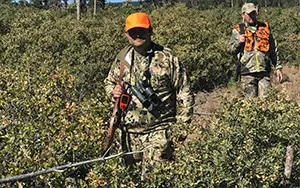
We were recently on a rifle hunt and stalking in on a herd of about 200 elk that were about 250 yards out. As we tried to get down to the edge of some oak brush, the hunter that was with me was wearing camo with a waterproof coating. The leaves and branches hitting his jacket made a loud scraping noise that the elk heard from 250 yards. Next thing we know, all their heads came up and they were out of there in an instant. Elk one, hunters zero!
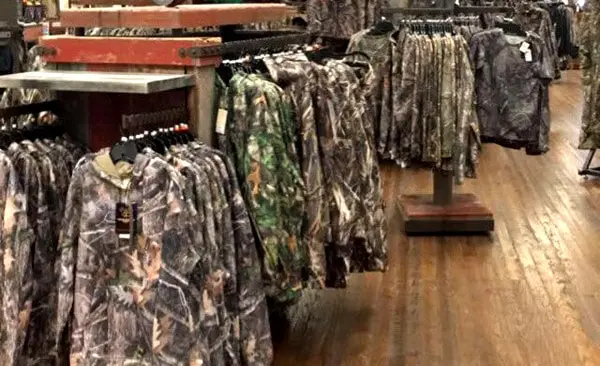
When we are checking out camo, the first thing we do is walk up to it and swipe our fingers and finger nails at it. If it makes that audible “shish” or “zzzzzzp” noise…moving on. Again, it DOES NOT matter how great the pattern.
Up next is the walking noise test. Take the two pant legs or the sleeves and rub them together. If you can hear an audible “shoooosh..shoooosh”, then it’s a no go for us. When we walk through the woods, we want to be able to hear and if our pant legs are making a swishing noise every time the loose material around our calves or thighs hit, then it makes it impossible to pick up other soft noises in the woods.
We have found that there are plenty of materials out there that meet our criteria. Cotton, wools, fleece, micro-fleece, and other synthetics can be pretty close to silent if not totally silent. Again at different price ranges and all with some pros and cons when it comes to longevity, odor control, pattern retention, warmth and moisture control. We recommend to work within your price range. Sure, there are some cotton products that will have pattern wear ofter so many washes, but at the price difference, someone on a tight budget may be able to buy 7 to 10 of them at the same cost as just 1 of the premium product lines.
Contrast of Pattern
First off, let’s introduce you to the technique that we use to check out the contrast of a camo pattern. Imagine you are Clint Eastwood in one of those shoot’em up westerns and someone just talked crap to you. That’s when you give the look….you know, the “you’re messing with the wrong guy, you piece of crap” look. The squint-eyed, “I’m about to kill you like a dirty dog” look.

We are not sure how good being squint-eyed is for a gun fight. But it is fantastic for seeing the contrast of items. It is actually a favorite technique of artists to determine the amount of contrast in the art that they are working.
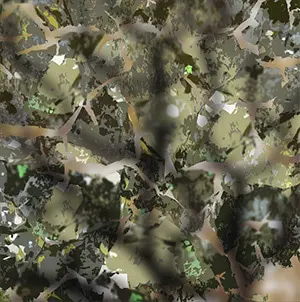
Contrast, the amount of lights against darks, varied in shape, tone and size are what really work to break you up in the woods or different terrains. Most patterns are going to look great close up. But, it’s when you look at them at a distance that the shapes and tones begin to show how effective they are or how much they will become a dark blob.
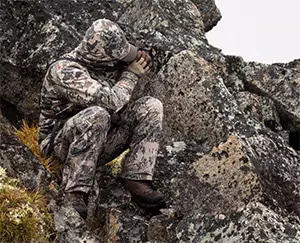
The whole idea is for you to be able to be IN FRONT of trees, branches or bushes to break up your silhouette and for your camo pattern to break up enough, have enough contrast in tones and shapes to let you blend into the background. By being in front of brush, branches or trees, you insure that you have better shooting lanes, therefore better opportunities for a clear shot.
Here is an example of how squinting can change the look of a pattern. We have digitally created a squinted version.
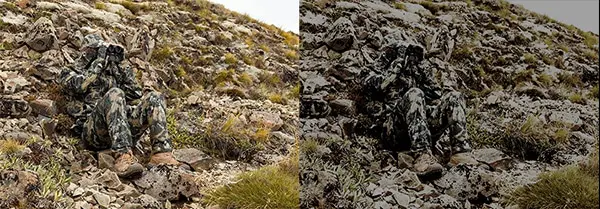
In the following images, you can see how different patterns look at a distance. The first is using the picture as is. The second is a squint version and the third is representative of how most people say an animal sees. In black and white. So which pattern do you think works the best? Why?
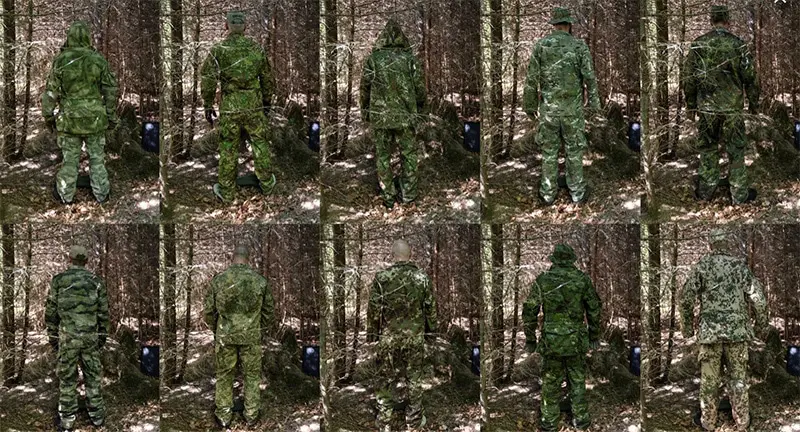
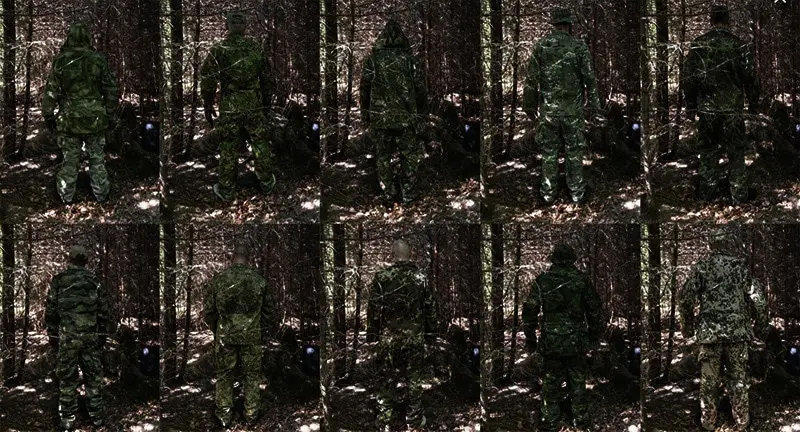
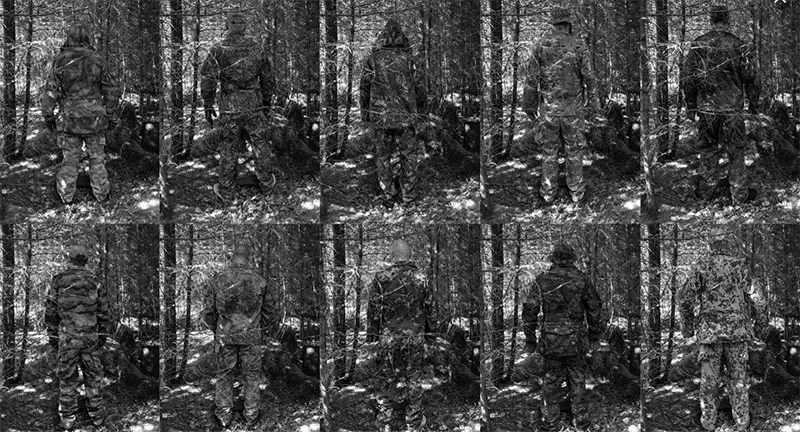
Just remember when picking out patterns that animals will be seeing you most of the time from about 20 yards and further away. So when looking for a good contrasting pattern, you need to back away to check it out. Look for those that can break up both at 20 yards and still not become a blob at 80 to 100 yards. Also be careful about wearing patterns that have faded after too many washings and totally lost all of their contrast.
3D Camo
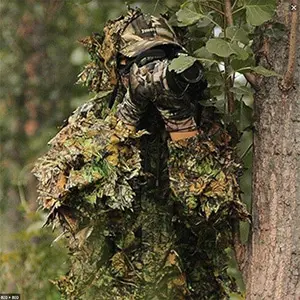
Some of us really like the 3D camo. It adds texture and contrast variations naturally when the light hits the 3 dimensional leaves or material cuts, doing a great job of breaking up your shape. Joe prefers to wear a 3D top with traditional camo pants and 3D hats. Again, to break up his shape just that much more. However, it is important to also use silent materials here as well. Some 3D outfits are very noisy, so pick wisely. If you are a bowhunter, you may also have to trim some of the leaves on the inside of your shooting arm to make sure that your bowstring does not catch on the material.
To Match or Not to Match
We often get this question about camo from our listeners and there are two points for our answer. First, coming from a budget point of view, wear what in the heck you have. Secondly, we have always worn a different pattern shirt with a different pattern vest with different patterned pants. The woods are full of varied textures, patterns and shades. With that in mind, we have always felt that wearing multiple patterns also helps you to break up your shape and to fit into your “NATURAL” surroundings even better. Simple answer, wear what you got.
Have more questions about camo? Send your questions to info@elkbros.com
